Hurricane Gloria was a most impolite lady. She barreled up the Atlantic coast, scaring the heck out of people from Florida to Massachusetts. Despite the fact that the storm didn’t live up to its billing, hundreds of boats in New York, Connecticut, Rhode Island, and Massachusetts were destroyed or severely damaged. In some cases, the boats were lost through no fault of the owner. No amount of preparation will save your boat if another boat drags down on it in the middle of a hurricane.

288
In other cases, however, lack of proper preparation was a major cause of a damaged boat. There’s no excuse for that type of loss.
Despite the fact that modern forecasting methods are far from perfect, a large storm such as Gloria almost always is tracked with enough precision to let you know if you’re potentially in the path of destruction. With a day or more of warning, you have plenty of time to take the precautions necessary to give your boat the best chance to survive a major storm.
Windage
When the load exerted on a boat’s ground tackle-whether a mooring or her own anchors-exceeds the holding power of the ground tackle, the boat will drag. One of the primary contributors to that load is the windage of the boat.
If your boat hung perfectly head to wind, the windage loading would be fairly small, consisting of the frontal area of the hull, deck structures, spars, and rigging in the case of a sailboat, and the hull, deck structures, bridge, and antennas of a powerboat. Unfortunately, few boats lie perfectly head to wind through a storm. Instead, they yaw about from side to side. As the boat sails around on her anchors or mooring, the total area presented to the wind, and hence the total loading on the ground tackle, varies dramatically. The area presented by any boat broadside to the wind is several times that presented by the same boat when it is perfectly head to wind. Since the change in wind loading is a function of the square of the wind velocity, the strain on your ground tackle increases geometrically as the boat yaws around. Reducing windage will help reduce the total loading, and hence help your boat stay put.
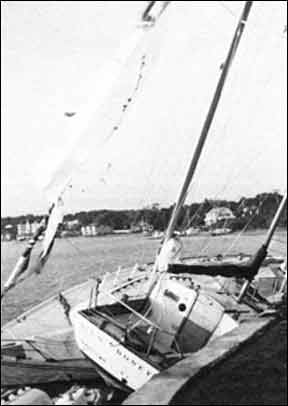
288
You can substantially reduce the windage of any boat with only a few hours of work. First, remove Bimini tops, cockpit dodgers, spray curtains around cockpits, and awnings. Those are pretty obvious. The rest may not be.
Sails should be removed, particularly roller furling headsails. You don’t just have to worry about the windage of the rolled-up sails, you have to worry about what will happen when the sail unfurls. And we practically guarantee it will, no matter how well tied it may be. Mainsails should be removed for the same reason. If the sail is so big that you can’t handle it yourself, and you have no one to help, add extra sail ties, and thoroughly and tightly lash down the sail cover. The normal securing system of the sail cover, and the normal amount of sail ties used, is not adequate to hold the sail in place during a major storm. If the sail gets loose, it will at least flog itself to death. At worst, it will add enough windage to make your boat drag its ground tackle.
Take off man overboard gear, cockpit cushions, cowl vents, antennas, and halyards, if the halyards can be rerove easily. Internal halyards can be run to the masthead, leaving a single halyard led to deck to allow you to retrieve the others after the storm. No matter how well you tie them off, halyards will flog hell out of your spars, in addition to being more windage. Likewise, masthead instrumentation may simply blow away, particularly your anemometer cups.
Get it Off the Boat
It’s a good idea to take everything that isn’t bolted down off the boat entirely. If a boat does go ashore, it’s a sad but true fact that vandals may make short work of her. Electronics, clocks, barometers, books, navigation gear may all vanish. If you value it, take if off the boat. Chances are that no insurance policy will cover you completely enough to make up for the loss of valuable gear.
Know Your Ground Tackle
Is your mooring really a 1000 pound mushroom with 3/4 ” chain? It may be worth hiring a diver to find out, preferably before a storm threatens. Likewise, all shackles, chains, and mooring pennants should be examined at least once a season to make sure they are in good shape. If the condition of any component of the system is questionable, replace it. If your insurance adjuster sees a corroded through piece of chain or a mooring pennant that is badly worn, he may well be reluctant to approve your claim in case of loss.
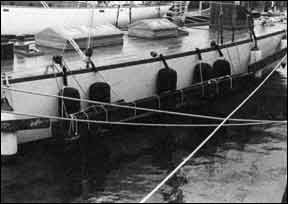
288
In crowded harbors, permanent moorings may lack adequate scope to deal with the high tides associated with storm conditions. It may be possible to increase scope for a storm by replacing or lengthening the mooring pennant. Just as with an anchor, the holding power of a permanent mooring is increased by additional scope.
Some moorings are equipped with large, inflatable surface buoys. The positive flotation of these buoys may reduce the holding power of the mooring in extreme high tides, so it may be worth removing the buoy before a storm; just don’t forget to replace it before casting off the mooring pennant after the storm is over.
At the Dock
As a rule, boats tied to docks are at greater risk than boats kept at moorings or on anchors. Floating docks are rarely strong enough to take the loads exerted on them by boats in storm conditions. In addition, if the tides are extremely high, floating docks may simply float off the pilings which hold them in place.
A boat kept at a dock can’t weathercock (face into the wind) as storm winds change direction. Therefore, the boat at a dock almost always presents more windage than a boat secured to moorings or anchors that is free to swing head to wind.
If your boat must be kept at a dock in a storm, secure the lines to the pilings, rather than to the floating docks. It is best to tie the lines high on the pilings, so they will not be chafed if the docks ride up on the pilings. Instead of using loose bowlines around the pilings, use multiple clove hitches, or a clove hitch finished with two half hitches. That way, the lines will tighten on the pilings, and are unlikely to pull off even if the pilings go under.
Anchored Out
If you have good ground tackle and a good mooring won’t have to worry about crashing into docks, or docks crashing into you. What you will have to worry about is other boats with less adequate ground tackle dragging down on you, either damaging your boat or straining your own ground tackle so much that your boat drags.
The first rule of thumb when anchored or moored during a severe storm is to get out as much ground tackle as possible. You may have a good permanent mooring, but if you back it up with your own anchors, you’re going to have an even better chance of survival.

288
Usually, it is possible to forecast the likely direction of the strongest winds, even with a hurricane whose exact path is unknown. A good rule of thumb is to deploy your heaviest anchor in the expected direction of the strongest winds, and your second anchor 180 ’ from that. You may want to put your primary anchor upwind of, and at a 45 ’ angle to, the mooring, so there will be less likelihood of chafe between your anchor rode and your mooring chain.
When putting out your anchors, get them as far from the boat as your rodes will allow, leaving yourself perhaps 25 ‘ of line on deck to make adjustments after the anchors are down. The more scope you have out on the anchors, the better they will hold. All anchors hold best when the pull on them is perfectly horizontal. You may increase the holding power of an anchor by 25 % by increasing the scope from 5:1 to 1O:1.
Remember that your biggest anchor does not necessarily have the most holding power in a particular bottom. If you’re anchored in soft mud, a Danforth will have much more holding power than a kedge anchor of the same weight.
Chafe
Line chafe has probably caused the loss of more boats than any other single factor. Whether you’re moored out or at the dock, your lines must be protected from chafe.
No matter how well polished your bow chocks are, they’re still metal, and are harder than your lines. In a storm lasting several hours, even the smoothest metal fittings will start to wear away your lines.
Chafing gear can be made from almost any sacrificial material. Canvas and leather are the traditional materials used, but “sticky dacron” sail repair cloth or even old towelling or T-shirts will do. Old denim blue jeans cut in strips make exceptionally good chafing gear.
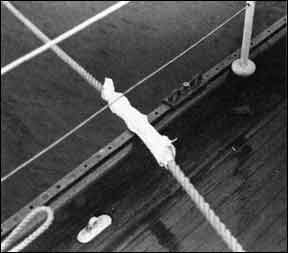
288
Chafing gear won’t do any good if it won’t stay in place. The best chafing gear is undoubtedly leather sewn over the lines, but if you’re preparing for a storm, it’s too late to be elegant. Duct tape-plenty of it-will do in a pinch.
You can also tie the chafing gear on with light nylon, but it, too will chafe.
Chafing gear should cover more of the line than you think will come into contact with a chafing hazard, to allow for fine tuning the lines, to compensate for stretch, and to make up for the fact that the chafing gear may slip under load. In addition, if you are aboard your boat during a storm, you may want to ease out a foot of line now and then to shift the location of chafe slightly.
Lines
Whenever possible, key dock lines should be doubled. If one fails, you want a backup. The only danger here is that the deck can quickly become a rat’s nest. In addition, those elegant little cleats may suddenly be too small to take two 3/4” dock lines. It is absolutely impossible for a boat to have cleats that are too large, just as it’s impossible to have anchors that are too big. All it takes is one storm to convince you of that.
Whenever possible, lead heavily loaded lines to winches before belaying them on cleats. Winches are likely to have more fastenings, distributing their load over a larger area of deck. Distributing the loads between a winch and a cleat can be a tricky business. Normally, when using a winch you take three turns around it, so that almost all the load is carried by the winch. Using only one or two turns on the winch allows more load to be carried by the cleat.
Don’t carry a lot of heavily loaded lines to a single cleat. That’s like putting all your eggs in one basket. If the cleat goes, the boat goes. This is when multiple cleats on the bow pay off. You can lead each anchor or mooring line to a separate cleat, not only making it easier to adjust individual lines, but distributing loads better.
Through bolted cleats are designed to be loaded in sheer; that is, with the load parallel to the cleat and perpendicular to the fastenings. When the load becomes a tension load-vertical to the fastenings-you’re headed for trouble. Watch the leads of lines carefully to load hardware properly. Sometimes, a strong snatch block can be used to deflect loading to a better angle, or to reduce chafe. For storm-induced loads, don’t use a block to change a lead more than about 45 ‘. You’re likely to induce loads on the block or its point of attachment that it just can’t handle.
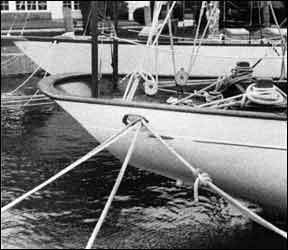
288
Lines may well pop out of open bow chocks as the boat pitches. It may be possible to lash lines into chocks by passing a light line under the bow or to adjacent hardware. Closed chocks work better, but once again you have to watch the direction of loading. Closed chocks are designed to be loaded downward, not upward. If you put a tension load on the chock’s fastenings, they may pull out of the deck.
Obviously, the strength of your deck hardware is extremely important, and the time to check it out is before there is a danger of storms. Proper backing plates, proper bolts, and strength of the deck and the fitting itself are critical. Winter is a good time to crawl around under the deck to check these things out. You’ll sleep a lot easier knowing just how hardware is attached.
Hauling Out
Usually, boatyards are overwhelmed with frantic calls from owners to haul their boats before a hurricane. Hauling may or may not be a good idea. Hauling a boat and leaving the mast in is an invitation to disaster. Hauling at a yard that is only a few feet above water level also may gain little. Putting the boat inside a shed that may blow down also gets you nothing.
By all means, if your boat is trailerable, get it out of the water. Tow it to high ground, but don’t park it under a tree!
On or Off the Boat?
If your boat is on an anchor or mooring, you may increase its chances of survival by staying on the boat. You may be able to fend off a boat dragging down, adjust a critical line, take the load off the ground tackle by running the engine. You also increase your chances of getting killed or injured. Boats are replaceable; people are not.
There is no easy answer to this one. Few things are more heartbreaking than watching another boat chafe through your anchor lines while you’re helpless on the shore. Few things are more terrifying than being aboard a boat that is dragging down to destruction on a granite seawall that towers over your head.
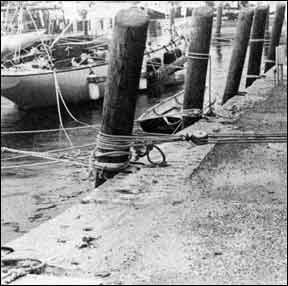
288
Should You Move Your Boat?
One of the most basic questions is whether your boat should be moved to another harbor. Most regions have protected anchorages known as hurricane holes. The only problem is that usually these are known to everyone, and may become so crowded when a major storm threatens that they become more dangerous than a more exposed anchorage.
Moving to a hurricane hole early is no guarantee of safety. You may get the best spot, but there’s no way to keep someone from anchoring right on top of you. If you think all boat owners are a generous and gentlemanly bunch, you haven’t seen them in time of stress when their boats are endangered.
You must realistically assess your chances for survival wherever you are. If strong southerlies are forecast in a harbor whose north end is a stone wall, you’d better think about moving elsewhere, or at least moving as close under the weather shore as is practical. Don’t forget to allow for changes in wind direction, however.
The wind itself is usually less of a problem than high tides and waves which reduce scope and increase chafe as the boat surges. If you’re behind a seawall which is only 5 ‘ above mean high water, a storm which comes at high tide is likely to submerge the breakwater, exposing you to the full force of wind and waves.
Use common sense. Try to imagine what will happen to docks, pilings, seawalls, and the other boats around you. What happens when the wind shifts? What if the docks come loose? Don’t move your boat until you have a coherent plan, and only if you can say with confidence that the place you have chosen is better than the place you are. An exposed location with a bottom that has good holding characteristics may be better than a protected location with lousy holding, if you have adequate ground tackle.
Finally
If you’ve done all you can to secure the boat-reducing windage, removing valuable gear, putting out extra lines, chafing gear, anchors-then you have done all that is reasonable to ask to prepare your boat to meet a storm in port. Get off the boat with a clear conscience, but try to stay as close as possible during the storm, as long as you don’t risk your life. If your boat does come ashore, you may be able to reduce damage or prevent vandalism if you’re close at hand. We have no sympathy for those who call the boatyard a few days after a storm to find out if their boat has survived.
One last thing to do is to take pictures of your preparations. If your insurance company questions the loss of your boat, it helps to have pictures of how you’ve prepared her. It may also help to prove a loss.
Mentally preparing for a storm in port is a lot like thinking about your emergency equipment. It may be unpleasant to think you’ll ever need it, but if you do, it’s nice to be familiar with how it works and what it can do. Careful preparation of your boat won’t guarantee its survival, but it will give it a far better chance.

































